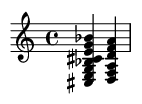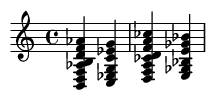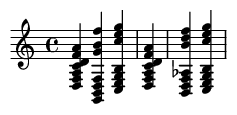Summary:
The diminished seventh chord is one of music's most dramatic and versatile harmonic tools. Built from a unique stack of minor thirds, this symmetrical chord creates intense tension that pulls powerfully toward resolution. This guide will teach you how to build, recognize, and use the diminished seventh chord to create smooth voice leading, sophisticated modulations, and gripping musical suspense.
Keywords:
diminished seventh chord, fully diminished chord, symmetrical chord, enharmonic equivalence, voice leading, chromatic harmony, tension and resolution, modulation, vii°7, jazz harmony
Introduction: What is the Diminished Seventh Chord?
In the world of Western harmony, few chords possess the enigmatic power of the diminished seventh. Instantly recognizable for its tense, unstable sound, it has been a favorite tool of composers for centuries to evoke drama, suspense, and mystery. From the intricate counterpoint of Bach to the climactic moments of a film score, this chord is a master of creating emotional weight and harmonic motion. Its unique, symmetrical structure is the key to its power, offering unparalleled possibilities for smooth transitions and key changes.
Construction: A Stack of Minor Thirds
The diminished seventh chord is a four-note chord (a tetrachord) built by stacking three consecutive minor thirds. A minor third is an interval of three semitones (or half steps). This construction gives it a specific intervallic formula from the root:
- Root (R)
- Minor Third (b3)
- Diminished Fifth (b5)
- Diminished Seventh (bb7)
For example, a C diminished seventh chord (C°7) contains the notes C, Eb, Gb, and Bbb. Note that the diminished seventh (Bbb) is enharmonically equivalent to a major sixth (A).
C Diminished Seventh Chord (C°7)
The Magic of Symmetry and Enharmonic Equivalence
The chord's most remarkable feature is its symmetry. Because it is built entirely of minor thirds, it divides the twelve-tone octave into four equal parts. This means that any inversion of a diminished seventh chord sounds identical and is, in fact, another diminished seventh chord. Consequently, there are only three unique diminished seventh chords in all of music!
For example, the notes in C°7 (C, Eb, Gb, Bbb/A) can be reordered to form Eb°7, Gb°7, and A°7. They are all the same collection of pitches, just spelled differently depending on the musical context.
The Three Families of Diminished Seventh Chords:
- Family 1: C°7, Eb°7, Gb°7, A°7 (Notes: C, Eb, Gb, A)
- Family 2: C#°7, E°7, G°7, Bb°7 (Notes: C#, E, G, Bb)
- Family 3: D°7, F°7, Ab°7, B°7 (Notes: D, F, Ab, B)
Harmonic Function: The Leading-Tone Chord
In tonal music, the diminished seventh chord's primary function is as a leading-tone chord. It is most often built on the seventh scale degree (the leading tone) of a major or minor key. In this role, it is labeled vii°7.
The intense pull of this chord comes from its internal tritones and its inherent desire to resolve. For example, C#°7 (C#, E, G, Bb) functions as the vii°7 of D minor. Each note has a strong tendency to resolve by half step to a note in the D minor tonic chord (D, F, A):
- C# (the leading tone) resolves up to D (the tonic).
- E resolves up to F.
- G resolves down to F.
- Bb resolves down to A.
Resolution and Voice Leading Excellence
The beauty of the diminished seventh lies in its smooth, satisfying resolution. The tendency of each note to move by half step creates exceptionally clean voice leading. This makes the intense dissonance of the chord feel purposeful and directed. Below is an example of C#°7 resolving to Dm, demonstrating this perfect voice leading.
Example: vii°7 resolving to i in D Minor

The Ultimate Modulation Tool
Because any diminished seventh chord can be enharmonically respelled as three others, a single chord can act as the leading-tone chord to four different major keys and four different minor keys. This makes it an incredibly powerful tool for modulation (changing keys) . By reinterpreting the chord's function, a composer can pivot to a distant key with surprising smoothness.
Example: One Chord, Two Destinations
Here, the same set of notes (B, D, F, Ab) is first used as B°7 to resolve to C minor. Then, it is respelled as D°7 to resolve to Eb minor.

Historical and Classical Use
First appearing in the Baroque era, the diminished seventh was fully embraced by composers like J.S. Bach. However, it was the Romantic composers—Beethoven, Chopin, Liszt, Wagner—who truly exploited its dramatic potential. They used it to build unbearable tension, express profound anguish, and navigate complex harmonic journeys. A famous example is the opening of the Adagio cantabile from Beethoven's "Pathétique" Sonata, where a diminished seventh chord immediately establishes a mood of deep pathos.
Jazz Applications: The Dominant Substitute
In jazz, the diminished seventh chord is a cornerstone of harmonic substitution. Its most common use is as a replacement for a dominant 7th chord with a flatted ninth (V7b9) . This works because a diminished seventh chord built on the 3rd, 5th, or b7th of a dominant chord contains all the same guide tones. For example, a G7b9 chord (G, B, D, F, Ab) contains a B°7 chord (B, D, F, Ab). Therefore, you can often substitute B°7 for G7b9 in a progression.
Example: A ii-V-I with Dominant Substitution
Measure 1 shows a standard ii-V-I in C Major. Measure 2 shows the V chord (G7) being replaced by a vii°7 chord (B°7), which creates a smooth, chromatic bass line (D - B - C).

Practice Techniques for Mastery
To fully internalize the sound and function of this chord, integrate these techniques into your practice routine:
- Spell and Play: Build a diminished seventh chord on every note of the chromatic scale. Play them as arpeggios and block chords.
- Practice Resolutions: For each of the three unique diminished chords, practice resolving it to all four of its possible major and minor keys.
- Ear Training: Use ear training apps or a piano to practice identifying the diminished seventh chord by its unique, tense sound.
- Analyze Music: Find diminished seventh chords in music you are playing or studying. Identify their root and their function in the progression (e.g., vii°7 of what key?) .
Fun Facts and Cultural Impact
The diminished seventh chord's tense sound has cemented its place in popular culture as the sound of melodrama and suspense. It became a cliché in the era of silent films, where organists would play it to signal that the villain had tied the heroine to the railroad tracks. This association, while sometimes parodied, highlights its raw emotional power. The chord's two interlocking tritones (the "diabolus in musica" or "devil in music" interval of the middle ages) contribute to its unsettling and dramatic character.
Conclusion: An Essential Harmonic Tool
The diminished seventh chord is far more than just a "tense-sounding chord." It is a marvel of harmonic engineering where mathematical symmetry meets profound emotional expression. Its ability to create powerful forward motion, facilitate seamless modulations, and inject drama makes it an indispensable tool for composers, arrangers, and improvisers. By understanding its construction, function, and possibilities, you unlock a new level of harmonic sophistication in your own musical vocabulary.
References:
Aldwell, Edward & Schachter, Carl. (2010). Harmony and Voice Leading. Cengage Learning.
Piston, Walter. (1987). Harmony. W. W. Norton & Company.
Levine, Mark. (1995). The Jazz Theory Book. Sher Music Co.
Kostka, Stefan & Payne, Dorothy. (2012). Tonal Harmony. McGraw-Hill.
